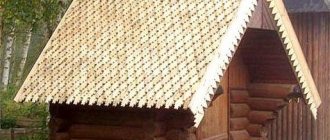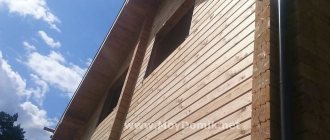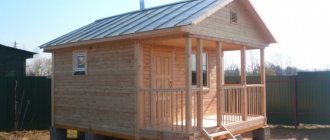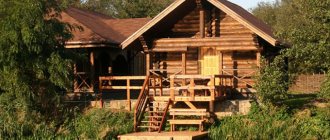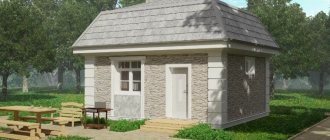In this article we will tell you how to make a clay brick with your own hands. This building material can be easily and inexpensively made independently.
Many of you know that red brick is a high-quality building material, but it is not at all cheap. I’ll tell you a secret: you can quite simply make it yourself, without incurring any special costs.
What kind of clay can you use for red brick?
The main raw material is brick clay, mined in a quarry . It is better to choose a deposit located close to the site. Take sand and clay in a dry place. Clay is transported in wheelbarrows and stored on wooden flooring in cones up to 1 m high.
You cannot take clay with pebbles, small pebbles, or white inclusions - carbonates. Therefore, the raw materials are first crushed and sifted through a sieve.
- The clay is placed in troughs and soaked in water. The liquid is added gradually, in 2-3 stages. The clay is not mixed, but rather soaked.
- The clay chaff is soaked for at least 3 days. At this time, the trough is covered with film so that the water does not evaporate.
- After aging, the raw materials are checked for suitability. For bricks, use low-fat clay - the amount of sand added is no more than 3-5%. Adding peat, sawdust, and husks to the mixture reduces fat content.
Determination of clay fat content
500 ml of clay is poured with water until it absorbs all the water and does not stick. The mixture is used to make a ball 4–5 cm in diameter and a cake 10 cm in size. The samples are dried for 3 days and then tested for strength. The ball is dropped from a height of 1 m: if it does not crack or crumble, the clay has optimal fat content. If it cracks, it’s too fat; if it bursts and crumbles, it’s skinny.
A cake made from too oily clay becomes covered with cracks after drying, a cake made from normal clay remains unharmed, and a cake made from thin clay crumbles.
They also resort to a more complex method . Mix the original clay in different ratios with water: 500 ml of clay and 250 ml of water, clay in half with water, and so on. A total of 5–10 samples are made. After drying, some of the balls are inspected, and some are dropped from a meter height. This method of evaluation requires more time, but is convenient because in the end the master immediately establishes the best ratio of water and clay.
Where there are no forests, but there is clay
Brick and its prototype adobe were widely used as the main building material in the southern treeless areas. The word adobe itself literally means straw, translated from the Turkic language. In the south, not only buildings, but even fences are actively being built from adobe and mud brick.
It is worth saying what a brick is in the general sense of the word. Brick is a rectangular building material made from mineral raw materials and has a number of fundamental qualities: strength, frost resistance and water resistance.
It has several main varieties:
- Ceramic, aka clay and aka red brick. Produced from certain types of clay, followed by high-temperature firing and slow cooling;
- Silicate, aka white. It consists mostly of sand and lime;
- Adobe, molded from clay and filler, which can be straw, manure, sawdust, grain cleaning waste, etc.;
- Hyperpressed consists of a dry mineral mixture by subjecting it to extremely high pressure;
- Bio, as a binder in its production, bio cement is used, obtained as a result of the microbiological transformation of calcium carbonate by the action of certain types of bacteria.
In addition, a standard brick has three main faces, which are determined by state standards and which form its geometric parameters:
- The bed is the main working side of the product, which is located parallel to the masonry line. Has the largest area;
- Spoon - a plane located perpendicular to the bed and having an average area relative to the rest;
- Poke - has the smallest area of all the faces, which is also located perpendicular to the bed. In everyday life, a poke is called a butt.
Size matters
For ease of use of this building material, produced by many manufacturers, back in 1927, an industry standard was adopted regulating the dimensions of commercial products:
- The nominal format NF 1 has basic dimensions of 250×120×65 mm, all others are derived from the nominal one;
- One and a half 1.4 NF 250×120×88 mm;
- Double 2.1 NF 250×120×138 mm;
- Eurobrick 0.7 NF 250×85×65 mm;
- Single modular 288×138×65 mm.
For ease of use when carrying out masonry work, manufacturers produce a number of products that have a full-length format:
- 3/4 - 180 mm;
- 1/2 - 120 mm;
- 1/4 - 65 mm.
Brick production technology
Making bricks requires space. For this purpose, a flooring is built. It is not recommended to dry the stone in the open sun: the material dries unevenly, and the risk of getting caught in the rain remains.
Mold making and molding
wooden or steel boxes with their own hands as a form . For the first, you will need boards 20–25 mm thick and plywood. Metal ones are riveted from iron sheets.
Clay shrinks when dried, so the dimensions of the template should be larger than the expected dimensions of the brick. For a block with dimensions of 250*120*65 mm, you need a mold with dimensions of 260*130*75 mm.
Templates can be collapsible or non-collapsible . The former are more convenient, as they allow you to remove the product without the risk of damaging it.
Manufacturing technology:
- To keep the inner surface of the mold smooth, it is lubricated with oil, whitewash or water. A layer of sawdust and sand is poured onto the bottom.
- The clay is placed inside the mold and compacted with a shovel. As the raw material shrinks, clay is added repeatedly until it fills the box to the brim.
- Excess mass is cut off with an iron or wooden strip.
- The surface is smoothed and the mold is removed. Raw clay bricks are “cured” in air for 1–2 hours. The process is considered complete if, when pressed, no traces remain on the surface of the raw material.
You can speed up molding if you use a simple screw press.
Another option is also allowed . They make templates for several bricks - in the form of a thick plate. In this case, after drying, the layer will need to be cut into blocks with a string.
Drying
Drying is deliberately carried out very slowly , since the main problem is uneven drying of the material. To avoid cracking and warping, drying is “stretched” for 15–20 days .
The bricks are left to dry in special sheds or under a canopy . Place the products in bags of 6–8 rows in height. Each row is sprinkled with sawdust or sand. The bottom row is placed on a stick to ensure uniform drying of the entire package.
The bricks are dried in a closed, dry room for 3 days, then the pallets are transferred to a ventilated area, protected from the sun.
Drying is carried out at an outside air temperature of at least +10 C.
Burning
Mud bricks are fired in kilns . It is better to use an analogue of a tandoor for this, but you can get by with a barrel stove. You cannot burn bricks on a fire.
Firing begins with the masonry to ensure uniform flow of flue gases across each brick. The stone is laid out according to a special pattern. The sequence is determined by the size of the furnace. The requirements are as follows:
- The density of the charge - laying during firing - is 220–240 pcs. not 1 cubic m;
- upward the density can be increased to 300 pieces per 1 cubic meter. m;
- the first 4 rows are laid according to the “legs of the garden” pattern - staggered in a herringbone pattern;
- the next 4 rows, if the height of the oven allows it, are laid in the same order, but at a smaller distance from each other and with a rotation at a certain angle;
- the raw material is stacked in columns with a distance of 8–10 cm between them.
A cage for a barrel or a small oven is much simpler. Here the raw material is laid in offset rows.
Firing is performed in several stages.
- The first is drying, removing internal moisture. Performed at the lowest temperature – +150ºС. It ends when condensation stops appearing on the upper surface of the masonry. Drying takes about 9 hours.
- At the second stage, the stove is heated so that a flame appears on top of the stove. In this case, the lower stones become yellow, and the upper ones acquire a faint red tint.
- At stage 3, the flame is extinguished, the firebox is filled with bricks and covered with clay. The oven cools down for 6 hours. After this, the front wall is disassembled and the brick is removed from the baked clay.
The uniformity of firing depends on the density of the charge. It is rarely possible to determine the correct design the first time, so it is better to make trial batches small.
Question to the expert
How to check the quality of finished bricks?
They split one brick, apparently intact and without cracks, and examine the chips on the fault. In well-fired clay, all chips have the same structure and shade. Then the fragments are filled with water. If after a couple of hours they still have the same color, the brick is of high quality.
How is drying carried out?
After light facing brick or any other is poured into molds, it is necessary to dry the raw materials. Successful drying consists of uniform evaporation of moisture from inside and outside. To bring the brick to readiness, separate rooms are used in which the raw brick dries for 5 to 20 days under normal weather conditions. In general, the drying algorithm looks like this:
- Lay out the finished forms in 6-8 rows high, sprinkling each layer with sawdust or dry sand, which can be found at home.
- As they dry, remove the finished fragments and display freshly prepared ones.
- After 3 days of drying indoors, it is necessary to ventilate the future building material in the fresh air.
To make the bricks of the highest quality, you need to cover the floor indoors with dry boards, and build a rain shelter outside.
Production safety rules
The stove should be placed at a distance from the house and access to it should be limited.
Making clay bricks involves the use of open fire sources. Safety measures must be strictly observed:
- the stove is installed in an area where maximum visibility is provided;
- place the structure at the required distance from wooden buildings and objects, green spaces and fences;
- control the cooling rate and temperature in the furnace throughout operation;
- restrict access to the site for children and pets;
- do not open the oven ahead of time;
- do not touch its surface during operation.
To prevent injury, keep a first aid kit on hand.
Product molding
Take some clay, put it in a mold and press it down on all sides. Make sure the corners are filled.
Here's how to make a brick using a do-it-yourself mold. First, wet the mold with water and sprinkle with cement. This will eliminate problems when removing bricks.
Place the clay mixture into the cells and shake the mold to distribute the clay into the corners. Excess material is carefully removed and covered with a lid. After time, you need to remove the homemade bricks.
Next, the main stage begins - drying. It is quite complicated due to the brick shrinking by 15%. It is most convenient to carry out the process on a rack with a canopy. It is important that the future building material is well blown by the wind and not exposed to sunlight or rain. This procedure takes from 6 to 15 days, depending on weather conditions. The higher the air temperature, the faster the products will become dry. So, the raw material is ready.
How to make products fired? Most likely, the household does not have an industrial kiln, so you will have to make your own equipment for making bricks at home. The firing process is complicated. It is unlikely that it will be possible to build a large-scale structure from homemade materials, but if 30-50 products are required, then it would be wise to start processing the product yourself.
Making gypsum tiles at home
If you simply mix plaster with water, it will turn out brittle and unsuitable for installation. To avoid this, you must do the following: mix gypsum with lime in the required proportions; carefully mix the solution using a drill with a special attachment;
pour the resulting mixture into molds and leave to dry (there should be no drafts or frosty air in the room).
Making gypsum tiles at home
A common problem that beginners face is the long mixing of gypsum, which leads to the fragility of the product or to the fact that the plaster in the mold does not harden at all and resembles a thick porridge. Another important feature is the removal of bubbles, due to which the finished product has an unpresentable appearance and a not very strong base. To get rid of bubbles, just place the mold on a vibrating table, which you can make yourself by spending 1 hour on it.
In order to give color to a product, you can add powder pigment to the solution, but the cost of such a dye is very expensive, it is sold in large packages, and after opening it has a short shelf life. Therefore, many find an alternative - dyes for paints. Many people add cement to it to give strength to gypsum. But professionals do not recommend doing this; over time, there is a possibility of the formation of fungus and mold, which, alas, are almost impossible to get rid of.
DIY firing
Making bricks at home requires only a barrel.
Its volume should be about 250 liters. You need to lay bricks made by yourself there. Leave a small distance between the products so that they heat evenly.
Pre-prepare a hole 40-50 cm deep for the fire pit.
For uniform heating of the products and convenient regulation of the fire, place the barrel on the fire with 20 cm legs. Now fill it with contents. Place the products one on top of the other, not forgetting to leave gaps. Then cover the barrel with a sheet of metal to prevent cold air from entering it. It is recommended to attach handles to the lid so as not to get burned when you need to remove it.
Bricks need to be fired for 18 to 20 hours. Maintain the fire under the barrel at the required level throughout the entire time. After this, allow the container to cool.
Do not remove the cover under any circumstances! The cooling process should occur slowly, gradually. It is necessary to regulate the temperature, slowly reducing the strength of the fire. 5 hours after the barrel has completely cooled, you can open the lid and take out the burnt brick. You should check the quality of the work done. To do this, carry out a test. You need to break one product with a hammer.
If all firing rules are followed, it will be the same color in all places. Next, pour water over the split building material. At the end of its stay in water, the product must also have a uniform structure and the same color. If the test is passed successfully, the firing process can be considered completed and you can continue to use building material made by yourself. Thus, a brick that is made on your own without a press or industrial equipment is in no way inferior to factory equipment. Nowadays, building materials are expensive. Even if the owners carry out all the work with their own hands, the construction of even small outbuildings is not accessible to everyone. However, you don’t always need to spend a lot of money; there are some ways out of a difficult situation. You can make bricks yourself, and save a lot of money. For example, you don’t have to buy bricks to build walls.
You can easily do it at home with your own hands, and although the cost will not be free, most of the finances will still remain in your pocket. Essentially, a brick is an artificial stone that has a rectangular shape. This form is much more convenient for construction than the form of natural stone from which buildings were built earlier. How to make such an artificial stone at home will be discussed in this article.
When working with plaster, you need to remember the following rules:
1. If it is not possible to purchase the necessary plasticizers, for better gluing, you can add citric acid to the solution (using the correct proportions).
2. The plaster in the mold hardens for 15 minutes, after which it must be removed and placed on a flat surface to dry completely.
In production, special drying chambers are used, in which the drying process occurs faster. Such a structure can also be built at home if you are going to make gypsum stone not only for yourself, but also for sale. The product dries within 8 hours, after which it can be laid on the walls.
3. The solution is made only for one pour; calculate everything in portions, since the remaining gypsum is unsuitable for the next pour (it will not harden).
We prepare raw materials
So, the plan is ready, it’s time to get down to business. To make bricks we need a lot of clay, since that is what they are made from. First of all, you need to find its deposit. In this case, it is advisable to choose one that is located as close as possible to the place of future production.
In addition, the area being developed must be dry, otherwise the work will be extremely difficult, if not completely impossible. For the job, you will need tools for cutting bushes, crushing, digging and loading. At a minimum, stock up on a crowbar, a shovel and a pitchfork. And don’t forget about the wheelbarrows on which you will transport the material to the production site.
Raw materials are extracted as follows:
- if the field is overgrown with grass, bushes and trees, then all this must be removed. Brush cutters and shovels will help you with this,
- To make it convenient to transport the mined clay, dig a trench along which you can roll a wheelbarrow to the mining site and back. It is advisable to line the bottom of the trench with boards, then the wheels will spin much easier,
- Then you can proceed directly to development. If the clay is loose, great, just dig it out with shovels. If it is quite dense or completely frozen, then you will have to work with a crowbar. Instead, a pickaxe is quite suitable,
- As excavation progresses, the clay is transferred to waiting wheelbarrows. It can stick to shovels. If this factor interferes greatly, then you can replace the shovel with a fork, the teeth of which are often located,
- Roll the loaded wheelbarrow to the storage location and unload it there. You should not throw all the extracted clay into one pile. It is better to make several cone-shaped embankments a meter high, and the diameter of the base of each of them should be about one and a half meters.
I remind you once again that for every thousand bricks you will have to extract two and a half cubic meters of clay. Don't forget to check your preliminary calculations.
It is advisable to add about 7-10% to them in case errors are made during the production of some bricks. After all, no one is immune from receiving defective products. Especially if this is your first time encountering this type of work.
Batch Type Floor Furnace
The place for the furnace is prepared in accordance with the same conditions as the production site, that is, it should not be subject to precipitation and floods, and so that the groundwater does not rise too much. Some high ground in the area is ideal for this.
Attention: When starting to build a furnace, you should decide on the scale of your production. For one and a half thousand products you will need a furnace one and a half meters wide, about two meters long, and at the top of the masonry from one and a half to eighty meters. The thickness of one brick is quite enough for such an adobe stove.
- The ceiling is installed on a metal base, so that each row of vault brick rests either on steel strips or on a metal frame.
- The arch above the masonry in the center should rise no less than 30-35 centimeters, and the oven chamber should be a through passage half a meter wide and 0.4 meters high. Along the entire passage, on both sides, ledges are made at a height of a quarter of a meter, for future grates when burning coal. If you are going to use only firewood, grates are not required.
- The fireplace is provided with a small square door approximately 40 by 40 centimeters, and the stove roof must be equipped with chimneys for smoke exit with a cross-section of 25 by 28 centimeters.
- If you know for sure that you will only heat with peat or brown coal, then the holes can be made somewhat smaller, about 25 by 15 centimeters, and equipped with lids for supplying fuel. The height of the pipe should be up to 5 meters, and its cross-section should be 40 by 40 centimeters.
- The pipe is placed behind the stove itself, and is connected to it by a chimney in the rear wall. Temporary holes are left exactly in the middle for viewing; later they are removed by covering them with clay. The optimal choice during laying would be a clay-sand mortar; only a small part of the wall in front is placed without mortar, because it will be periodically disassembled to cut the cage.
Why is it convenient to make gypsum stone at home?
1. Convenient molds for casting stone, non-bulky, take up little space.2. No vibration table required.3. Clear and simple painting technology.
4. Low cost of mixtures and substances for producing the material.
In addition to making gypsum stone to decorate their premises, many are engaged in its production for commercial purposes. The costs are low and the payback is quick. Moreover, the product is in great demand in the construction market.
The right preparation process
Since the most important element of brick is clay, it must be of excellent quality and without any impurities.
Fortunately, finding clay is quite easy, because it is distributed almost everywhere in our latitudes. But if there is no way to get the mineral yourself, then buying it will not hurt your wallet. In any case, it is much cheaper than buying ready-made bricks.
If you decide to make adobe without firing, then it is important to take care of the straw in advance. There is no fundamental difference here - it can be made from almost any plant: wheat, rye, barley, oats and others. The main thing to take care of is to choose good, not rotten straw and chop it, because coarse straw is not suitable for a small brick.
Video on the topic: DIY silicone mold for decorative stone
Silicone molds are not as durable. Used only for plaster. When working with such forms, you need to carefully remove the finished product, as the plaster can crumble like chocolate.
Also, to produce gypsum, you will need a deep container (it is better to use plastic products, as the plaster can be washed off better in the future), a drill with a rod attachment in order to stir the mixture, and a flat table.
DIY firing
It is necessary to lay bricks in a barrel, leaving small gaps for uniform heating.
Since no one has an industrial kiln at home, all that remains is to try to do it in an ordinary barrel with a volume of 200-250 liters.
You definitely need a pit for the fire, 40-50 cm deep. The bottom of the barrel is cut out and the barrel is placed on the fire on legs 20 cm high. This will make it more convenient to maintain and regulate the fire, and the heating of the mass of bricks will be uniform.
Now the barrel needs to be filled with bricks.
They must be laid with small gaps, one on top of the other. Then, to prevent cold air from entering the barrel during firing, it is necessary to cover it with a metal sheet. A cut-out bottom can come in handy here; it will be especially convenient if handles are attached to it.
Now you need to stock up on fuel and patience. The process takes from 18 to 20 hours, during all this time, while the bricks are being fired, it is necessary to maintain the fire under the barrel.
After this, the barrel should cool down.
This should happen gradually, and the lid should not be opened. You need to regulate the temperature in stages, reducing the flame of the fire. An artificial cooling method will not work here; cooling must be only natural.
4-5 hours after the barrel and its contents have completely cooled, you can open the lid and remove the finished fired products.
The quality of the work done needs to be checked and a small test done for this.
For this you will need to sacrifice one brick and split it with a construction hammer.
If it is well fired, it will have the same color and the same structure throughout the entire fault. Now these fragments should be filled with water for several hours. After being in water, a well-fired brick should also have the same color and structure over its entire surface.
If everything is done and the quality is high, it means that the firing process on your own is over. Thus, it is clear that it is quite possible to make artificial stone, which was produced without using a press or other industrial equipment.
Decorative gypsum stone is a material that is great for interior decoration. It has excellent properties and qualities, and therefore is an indispensable material during repairs.
The stone has a number of advantages:
safe, environmentally friendly; serves as a natural air humidifier in the room; practical; excellent quality of material; large selection of shapes, structures, colors;
low cost.
There is a lot of information on the Internet about how to make and lay gypsum stone yourself, but it is better to get information from trusted sources, for example, people who work as builders, they have repeatedly dealt with similar material. Such practical advice will be discussed later in the article.
There are a lot of ways to prepare stone, lay it, paint it, and make a mixture for fastening. Many people add additional ingredients to plaster: lemon, lime, special glue, you can add all this at your discretion. But in the “classic” options for creating and laying gypsum stone, there are no such ingredients. Gypsum tiles are suitable for decorating a room made in any style: high-tech, modern, baroque, classic and others.
The tiles can be used for both exterior and interior decoration. Gypsum tiles are suitable for decorating a room made in any style: high-tech, modern, baroque, classic and others. If we consider the option of decorating inside a room, such gypsum tiles will create a festive atmosphere , it makes you pay attention, attracts the eye. Tiles are convenient to use to hide defects in buildings (unevenness of walls, corners, ceilings). The finishing option will depend on what exactly you want to highlight. Many people decorate window openings, arches, doorways, stairs, fireplaces with such tiles. There are options when you need to cover the entire wall with gypsum tiles.
At the same time, the stones have an interesting structure and texture, so they look beautiful and bring elements of wealth and luxury to the interior. There are a lot of options in terms of sizes, textures, and colors, so you can choose something that will look really good and combine with the overall style of the room and apartment as a whole. If you compare two materials such as concrete and plaster, the second, of course, loses in terms of its strength. But production does not stand still; there are special additives (polymers) that increase the strength of the product.
We hope that in the near future gypsum will become as strong as concrete. For example, in China, gypsum is used in the construction of bridges, while adding gypsum polymer additives. And in terms of strength, it is not inferior to a concrete bridge, as proven by experts. In our country at the moment there are no cases of using gypsum for the construction of bridges or other structures that must have a large load capacity.


